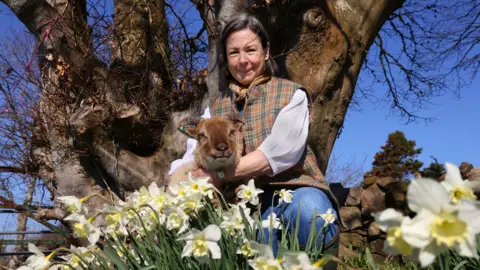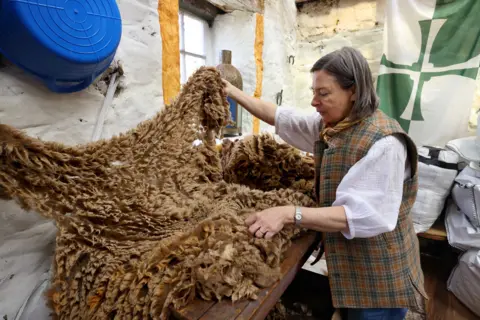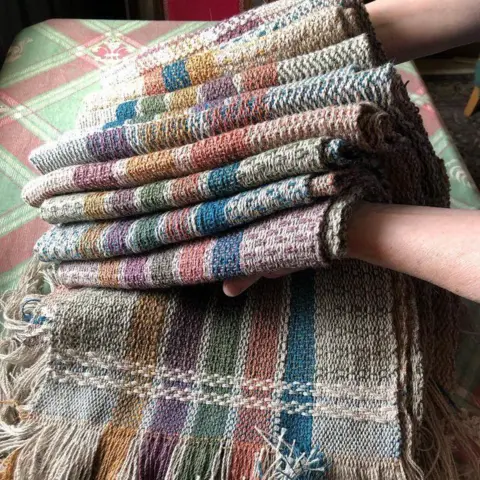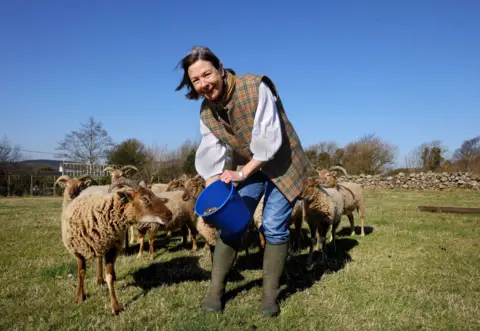How scarves could help to save a rare Scots sheep breed
 Colin Hattersley
Colin HattersleyRebecca McLellan is trying to safeguard the future of a rare breed of sheep one scarf at a time.
She fell in love with the Castlemilk Moorit and now has her own flock of 18 on the farm where she and her husband live in Rockcliffe on the Solway Firth.
Rebecca was keen to look at ways to help ensure the long-term survival of the sheep, which are on the Rare Breeds Survival Trust (RBST) "at risk" list.
That was when she hit on the idea of learning to weave to try to encourage other potential breeders to follow her lead.
 Colin Hattersley
Colin HattersleyShe was born in Kenya and worked in London before moving to Scotland to a house which had been in her husband's family for about a century.
"With that came the responsibility and the stewardship for that land," she said.
"The reality was it had always been grazed by sheep, so we took a look at it and thought, well, there we go, that's the answer - we've got to get some sheep."
After that they had to narrow it down to what type.
"Some native breeds in Scotland are becoming ever rarer, and I'm mad about my conservation," she said.
"We started to look for rare breed of sheep that were native specifically to this corner of Scotland and settled on the Castlemilk Moorit."
 Chocflock
ChocflockThe brown-coated, curly-horned sheep were originally bred in the 1920s by Sir John Buchanan-Jardine for his Castlemilk estate in Dumfriesshire.
They are on the "at risk" list, with an estimated breeding population of between 900 and 1,500.
Rebecca said they were originally bred as a "park sheep".
"They are an elegant-looking breed of sheep," she explained.
"They've got sweeping back horns, they've got neat legs and a sort of gazelle or deer-like head.
"So they grace the field - but they also have this practical side with the fleece.
"It is a soft fleece - I blend it to make it go further - but it's a soft mocha colour, it is cream at the tip down to chocolate at the base."
She describes the sheep as "quite flighty" but also "quite curious".
"If you do anything in the field or anywhere near them within a blink of an eye, they're all standing around in a circle, watching," she said.
 Colin Hattersley
Colin HattersleyRebecca turns their fleeces into tapestries, knitwear and upholstery and hopes her work can help save the breed by showing the value they can offer.
"We've got breeds that have developed and evolved in Scotland particularly - but across the UK - which suit the geographical nature of our landscape," she said.
"So you're not trying to raise a breed of sheep that isn't suited to where you are from.
"There's a reality that these are breeds that need to be helped to survive and not sort of forgotten in the rush to have ever more economical sheep which are good for raising just for meat."
Rebecca is throwing open the doors to her workshop as part of the Spring Fling open studios event across Dumfries and Galloway between 24 and 26 May.
Visitors will get a chance to see what she produces, how she does it and meet the rare breed itself.
In the process, she hopes it might convince a few more people that the Castlemilk Moorit deserves to flourish in the years to come.
